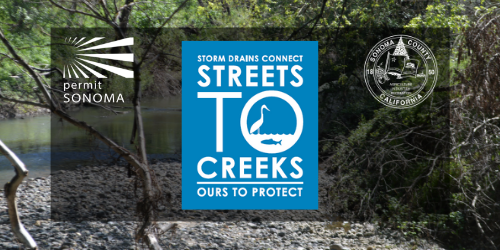Storm Water and Water Quality Programs

Clean Streams in Southern Sonoma County
Permit Sonoma is part of public/private partnerships to reduce pollution in the Sonoma Creek and Petaluma River watersheds.
Stormwater runoff occurs when rainfall flows over the ground. Impervious surfaces like parking lots, rooftops, and streets prevent stormwater from naturally soaking into the ground. More impervious surfaces mean more stormwater runoff entering the County’s storm drain system which includes curb inlets, underground pipes, roadside ditches, creeks, streams, and rivers.
Non-point source pollution is caused by pollutants of varying origins and occurs when stormwater runoff picks up and carries debris, chemicals, dirt, and other pollutants into our storm drain system. Anything that enters our storm drain system is discharged untreated into the waterbodies we use for swimming, fishing, recreation, and drinking water.
Some common pollutants found in storm drains and creeks include motor oil, yard clippings, fertilizers, pesticides, milky water from paint, soapy water from car washing, eroded sediment, and concrete by-products from construction projects and litter. Because all runoff cannot be captured and treated like sewage, the best prospect for cleaner water is to prevent runoff from becoming polluted in the first place.
Storm Drain Systems vs. Sanitary Sewer Systems
A storm drain system is designed to prevent flooding by collecting surface runoff through various inlets (like curb openings and parking lot grates) and conveyance systems (like ditches, swales, and pipes) and then discharging it to a natural waterway (like a creek or river). Storm drains are also known as storm sewers. The water in the storm drain system does not receive any treatment. Anything located outside that can be washed away by water has the potential to enter a storm drain system and our waterways. This includes motor oils in driveways, pet waste on lawns, and soapy water from car washing.
A sanitary sewer system collects and transports waste from indoor plumbing fixtures to treatment plants. Private septic systems also collect waste from indoor plumbing fixtures but the contents are contained within the owner’s property. Septic systems should be maintained on a regular basis and should not be discharged over land or into a storm drain system.
Keep Sonoma Water Clean – Prevent Storm Water Pollution
Water is life. Keep our water clean and wildlife safe!

 Translate
Translate